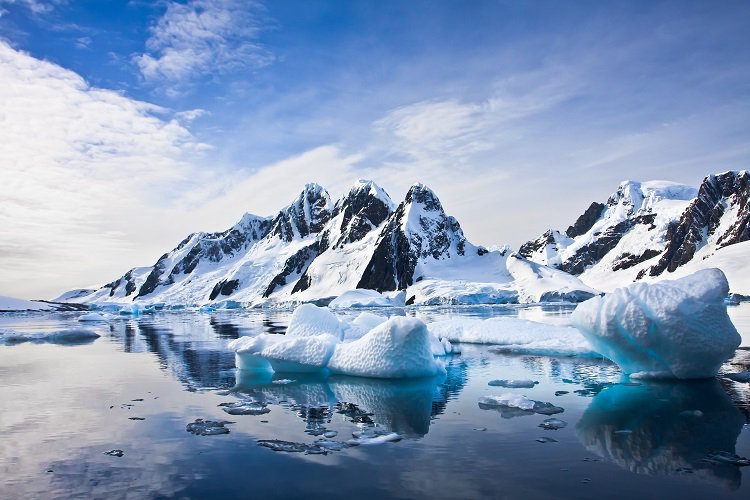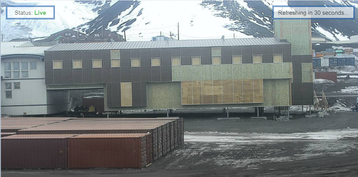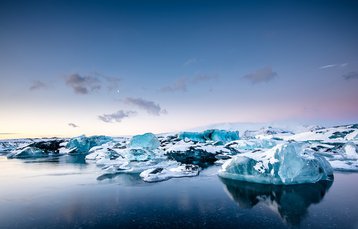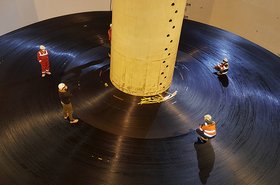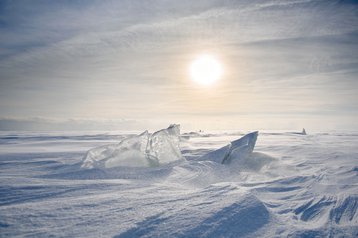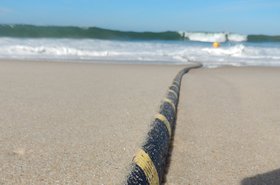Despite the recent boom in subsea Internet cables, Antarctica remains the last unconnected continent. In its long summer, it is home to dozens of research stations hosting thousands of researchers, who generate terabytes of data a day. But the whole continent relies on satellite connectivity which barely qualifies as broadband.
Terrestrial subsea cables can now reach up to 300 terabits per second (Tbps) but Antarctica gets less than 30Mbps from its satellite links Even the International Space Station, in Earth orbit, does better than our most southern continent; at 600 megabits-per-second - more than 20 times the bandwidth of the US’ McMurdo research station.
But, nearly a decade after it was last considered, 2021 has seen a flurry of interest in finally laying a cable to Antarctica that could revolutionize the way scientists conduct their research.
Megabit Internet in the Antarctic
Both McMurdo and New Zealand’s Scott Base are on Ross Island, which is 20miles off the Antarctic coast, and the southernmost island in the world, some 4,000 km (2,400 miles) south of Christchurch, New Zealand.
Until last year, the Scott Base relied on a 2Mbps satellite connection, but recently upgraded to 10Mbps download / 6Mbps upload from IntelSat with 300ms latency between Scott Base and New Zealand. The US McMurdo station, on the Southern tip of Ross Island, has something closer to 25Mbps to share between up to 1,000 people in the Austral summer.
“I've seen the Antarctic program evolve from relying on point-to-point HF radio that was used to move data from McMurdo and South Pole stations in the 80s and early ‘90s to modern satellite communications,” Patrick Smith tells DCD.
Smith is manager of technology development and polar research support at the National Science Foundation – the US government’s science agency: “We're trying to run a science town that supports all the logistical things it has to do; software updates, exchanging database files, moving cargo between us and logistics centers up north, supporting the scientists and our telephone systems, email, and medical video teleconferencing.
“We're doing all this incredible amount of stuff with the amount of bandwidth that's typically available for one household in rural America, and we're starting to hit the practical limits of being able to keep growing and expanding.” He says that even a 100Gbps cable would be “essentially infinite bandwidth” for McMurdo and could relieve a lot of the constraints.
Can NSF make a subsea cable?
This year the NSF put on a workshop to discuss how a cable would change the lives and research of scientists and staff stations in Antarctica, and is in the process of feasibility study ahead of potentially developing its own cable to the continent.
After decades of relying on satellites, the workshop produced a comprehensive report detailing the impacts of how a cable and a huge bandwidth boost could benefit research, logistics & safety, and the personal lives of the Antarctic mission.
“A combination of new US science experiments requires the US to think differently about their data transfer requirements, and redevelopment of NZ and US Antarctic bases has forced both programs to look to the future and address long-standing connectivity issues,” says Dr. John Cottle, chief scientific advisor to Antarctica New Zealand, the government agency responsible for carrying out New Zealand's activities in Antarctica.
“As science, associated technology, and data storage methods progress,it’s natural that much greater amounts of data will be collected by scientists and they will want to transfer this data to their home institutions for processing. Financially, a cable begins to make more sense as data volumes rise, and I [also] think there is generally a greater demand and expectation for connectivity in all aspects of life.”
Smith says the NSF first looked at the feasibility of a subsea cable from Australasia to Ross Island around 10 years ago, driven partly by the then-proposed Pacific Fibre cable that would have gone from Australia to New Zealand and onto the US. However, PF folded in 2012 and Smith says the NSF let the topic ‘go dormant.’
But two recent developments re-ignited NSF’s attention: Chile’s Humboldt cable is due to connect South America with Asia. Meanwhile, Datagrid is building a 50MW hyperscale facility on New Zealand’s South Island near Invercargill. “The needs and the demand to help support the growth of our science program have shifted the direction towards [a cable]. As the need and desire for digital transformation have grown, we’ve bumped into some limits of what you can do with just regular conventional satellites.”
A number of researchers DCD spoke to note the current US administration under President Biden is more likely to favor large science projects with a strong climate component than the previous Trump regime.
“The NSF, all of a sudden, has a bit of a fire under it to explore this idea,” says Professor Peter Neff of the University of Minnesota’s Department of Soil, Water, and Climate, who helped put on the workshop.
The race to connect Antarctica heats up
After years of little activity, suddenly there are a number of potential cable projects looking at connecting Antarctica to both South America as well as Australasia.
In May 2021 Silica Networks, a Datco Group company, announced it was to spend $2 million on a feasibility study for linking Ushuaia in Argentina, Peurto Williams near Cape Horn (Chile’s southernmost point), and Antarctica’s King George Island, located 1,000km to the south and home to nearly a dozen research stations. In November, the Chilean government also signed an agreement to explore the possibility of a subsea cable from Puerto Williams to King George Island.
“We are taking the first step to create an Antarctic digital hub,” said the Chilean Undersecretary of Telecommunications, Francisco Moreno. “We aspire that the large volumes of scientific information... circulate from Antarctica to the rest of the world through Chilean telecommunications networks.”
On the Australasian side of the continent, there are a number of potential cable projects in the works beyond the NSF’s potential cable. In a February 2021 submission to the Joint Standing Committee on the National Capital and External Territories, the Australian Bureau of Meteorology (BoM) discussed the possibility of a subsea cable connecting Mawson, Davis, and Casey stations on the Antarctic continent, and the Macquarie Island research station, to Tasmania.
“Establishing an intercontinental submarine cable to Antarctica may be beneficial to Australian interests, and better ensure safe and secure operations in the territory by diversifying the communication infrastructure used to operate the Bureau’s Antarctic meteorological services and allow for the expansion of services and capabilities across the vast continent,” the report said.
According to ZDNet, the Australian Antarctic Division currently uses C-band satellite connections from Speedcast at each of its four stations, which are capable of 9Mbps and have 300ms of latency. Each station also has a backup data link from the Inmarsat Broadband Global Area Network, which provides a 0.65Mbps link with a latency of 700 milliseconds.
Remi Galasso is involved in two potential projects. He is the founder of Hawaiki Cable, which links Australia, New Zealand, Hawaii, and the US West Coast. His other venture Datagrid has a hyperscale project on South Island with a fiber connection between New Zealand and Australia. That cable could include the potential for expansion to Ross Island. Galasso is also reportedly in talks with Chilean officials about the possibility of landing the Asia-South America Digital Gateway project connecting South America to Asia Pacific on New Zealand’s South Island rather than Auckland to the north, and this could feature a spur to Antarctica. The venture would be separate from Hawaiki.
Australia’s Norrlink is a newly-established company aiming to connect Hobart in Tasmania, Macquarie Island, McMurdo & Scott research stations on Ross Island, and the Italian Zucchelli research station at Terra Nova Bay.
Joe Harvey, managing director at Norrlink, tells DCD the company aims to develop a cable funded by a consortium made of up the science community with interests in Antarctica. He says the company is currently in discussions with potential customers, is focused on forming the consortium to assemble funding, and is “optimistic” that it will place the order by mid-2022.
“Currently we are focused on forming the consortium to assemble funding,” he says. “This is a research-focused cable and the project differs greatly from a standard commercial sub-sea revenue-producing fiber project.”
He said there is interest around building the first LEO satellite earth stations and sees “great potential” to work with the likes of OneWeb and Starlink on a landing point on the continent, and that a cable could enable more remote commercial experiments akin to those that take place ISS.
How an Antarctic cable could help people, research, and safety
A cable to McMurdo and other research bases could be transformative for scientists’ research as well as their quality of life.
On the research side, more data is generated by scientists than can be sent out, so information is often compressed and pared down to be sent out in subsamples via satellite. Raw data is then flown out via hard drives. A cable could allow scientists to record and send far more data back to their respective research institutions much faster.
“Scarcity is the mode for everything down there, from luxuries like food and being warm all the time, all the way to having good Internet or not,” says UoM’s Neff. “We're definitely used to not doing much with data when we're in Antarctica; we design all of our experiments based on this assumption of the scarcity of resources.
“If we were to have full-fiber Internet, we can start going wild with our imagination of all the ways we get improved science. Having better bandwidth would fundamentally change the way that humans work down there.”
Likewise, Antarctica NZ’s Cottle says a cable that went to Scott Base could enable year-round monitoring of Ross Sea and Southern Ocean, and remote control and tracking of air and undersea drones alongside weather balloons; more real-time observations and increased data density for geographic, atmospheric, oceanographic, and meteorological data; and even enable the base to begin to use cloud computing for large data sets.
The atmospheric research community in particular is very interested in getting more real-time data and visuals out. The weather influences everything on the Antarctic continent; flights to McMurdo, the South Pole, and other field locations sometimes have to turn back because weather conditions make it dangerous to land.
The Antarctic mesoscale prediction system uses data collected from Antarctica and processes it at the National Center for Atmospheric Research to provide a detailed view of the weather systems around McMurdo and the surrounding area. A cable would allow more data to be sent to the US more quickly, allowing for more accurate long-term predictions and the ability to send more information back to McMurdo in closer to real-time.
“If the bandwidth was there the information could come out of the National Center for Atmospheric Research where the model is run, onto the ice to have a much more comprehensive description of what's happening,” explains Professor David Bromwich, a polar meteorologist at Ohio State University. “Things can change very rapidly down there. [Right now] you've got what's going to happen over the next few hours, but the NSF wants to expand the field season away from just the warmer months so that they can do some activities throughout the year. And so then the question becomes what is it like not just over the next few hours, but over the next few days?”
McMurdo is a major logistics hub for scientists traveling on to the South Pole, field stations, or other research bases, and having greater bandwidth offers researchers the chance to be more productive while they wait to move on. Adding a cable could improve the quality of life for people stationed at McMurdo immensely. Wi-Fi access is currently restricted to science personnel and only in certain buildings.
“It's a small town; there could be anywhere from 500 to 1,000 people at its peak, and they're trying to maintain their lives back home while they're still deployed in the Antarctic,” says NSF’s Smith. “Contact with family and friends, maybe even paying bills and the other things, removing these bandwidth constraints just makes it a lot easier.”
And while it may sound trivial compared to science research or predicting potentially deadly weather, a cable will also enable greater access to social media. The NSF is always keen to promote science, and unfettered capabilities around video calls and social media can help spread the word of polar science. TikTok videos from two researchers at the South Pole have regularly gone viral over the last year and shown how powerful social media can be.
“Even things like our educational outreach require modern digital communications,” says NSF’s Smith. “A lot of our grantees try to do educational outreach sessions using social media, which we have to limit. Taking that constraint off, they could do things like live sessions with classrooms.” Neff notes that the human aspect of life in Antarctica can be lost in the research endeavor, and more bandwidth would make it easier to share the whole experience.
“The product of our research projects is usually a paper in the Journal of Glaciology, but that doesn't do justice to the massive human effort of those people supporting you. None of that is captured in our outputs,” he says.
“It would add a lot of additional depth to communicate better what doing science means and the genuine teamwork it involves; you have to really care about everybody on your project, whether or not they have a PhD doesn't matter when you're in Antarctica.”
Subsea cables in sub-zero temperatures
Smith says the NSF has a desktop study being commissioned with assistance from the Defense Information Systems Agency (DISA) – which he says is the governmental subject matter expert in this area – to explore the feasibility, costs, and timelines of a potential cable project and address what he describes as “Antarctic uniques.”
As well as ensuring a cable would be routed and protected to avoid icebergs gouging the seafloor, icebreakers would almost certainly be needed, and there may be a very limited window to lay a cable. The Southern Ocean is also notably difficult to navigate.
“No one's laid a cable in the Antarctic before, I would not be surprised if there are some challenges that we'll have to come to terms with and figure out,” Smith says. “What's the iceberg scour risk; we need to make sure we understand what the bathymetry is like; what does it mean to try to lay cable when you only have limited ice-free cover; what are the sea-states; and can you get cable ships that are rated to operate in polar regions?”
Nobody has laid a cable in the Antarctic, but there are some parallels with cables laid in the Arctic. Cables connecting Greenland to Canada and Iceland were laid in 2010, while cables linking the island of Svalbard to Norway and Finland were laid in 2002.
Alaskan communications firm Quintillion partnered with Ciena for its 2017 Alaskan Subsea Cable – which it plans to extend to Europe – and Russia is planning to lay the Polar Express cable along its northern Arctic coast. Brian Lavallée, senior director at Ciena says laying cables in polar regions is challenging but possible.
“Ice-related challenges greatly influence cable installation, protection, and maintenance,” he says. “Modified or purpose-built ships capable of navigating icy Arctic/Antarctic waterways are required, which may be accompanied by purpose-built ice-breaker ships because laying a submarine cable follows a predetermined surveyed path of which parts may be frozen.”
“Changes to the cable itself will likely be minor to unnecessary in most cases, as there are existing cables already in cold waters. Installation and burial methods, as well as armoring, may be customized to where the submarine cable is physically installed.”
Smith notes, however, that the ocean area the cable would pass through has been studied extensively through international science programs of not only the US but also the likes of New Zealand and South Korea.
“There's a wealth of scientific information and a body of knowledge from a whole range of disciplines from people who study the ice sheets; icebergs; the ocean bottom and iceberg scour; the benthic [sea bottom] community of organic life. I believe that there is going to be a large body of scientific knowledge that the desktop study can tap into.”
SMART cables become scientific instruments
One unexpected benefit of any cable to Antarctica flagged at the workshop is that it could be used not only to carry scientific data, but become a research instrument itself.
“The instrumentation of the cable opens up some exciting possibilities for oceanographic research in an area of the world that really doesn't have that much in the way of sustained monitoring,” says Smith. “A lot of connections were drawn between the instrumentations on a cable and how that could benefit climate change research, and long-term monitoring that’s essential for climate change monitoring.”
Scientific Monitoring And Reliable Telecommunications (SMART) Cable Systems insert sensors into subsea cable repeaters, providing continuous information on ocean temperature and water pressure at regular distance intervals.
Potential projects are in discussion for deployment off the coasts of Sicily, Portugal, Vanuatu, and New Zealand. “It [would] provide a new window into the deep ocean,” says Professor Bruce Howe, Research Professor at the University of Hawaii’s Department of Ocean and Resources Engineering, School of Ocean and Earth Science and Technology (SOEST). “They are so few measurements, and whatever measurements we have are typically very intermittent.”
Dedicated science cables are rare, numbering in the dozens compared to the 400 or so commercial subsea cables. Most oceanographic research data is collected via ships and buoys, which are expensive and often only provide isolated and intermittent data. A SMART cable could provide huge amounts of new information.
“By adding 2,000 repeaters with deep temperature measurements, that would be 2,000 measurements we don't have [currently],” says Howe. “We would be providing a time and space-dependent measurement of sea-level rise as waters melting from different locations and flowing around the globe try to equilibrate.”
By measuring water pressure, for example, scientists can track sea-level rise. More water in the ocean increases the pressure on the bottom. A cable from New Zealand to Antarctica would serve more directly to measure the formation of Arctic bottom water.
“The coldest water in the ocean is formed in Antarctica, and sinks down and spreads out through the global ocean,” says Howe. “One of the formation areas is the Ross Sea where that cable would go, so you would have direct measurements of temperature versus time going out over 5,000 kilometers. That would be a direct, great benefit.”
At an industry average of around $30,000 per kilometer, a 3,500km or so cable from NZ to Ross Island could cost the NSF somewhere in the region of $100 million, before adding the cost of SMART repeaters, the likely extra cost of icebreaker ships, etc.
Howe says he and the ITU task force calculate SMART cables increase the cost of a cable by around 10 percent. But the scientific benefit could help the NSF justify the cost of the whole project.
The NSF’s annual budget is around $8 billion, with around $500 million of that dedicated to the polar mission. The Innovation and Competition Act of 2021 is yet to pass, but could potentially increase NSF’s budgets by tens of billions of dollars over Biden’s term.
In the meantime, the NSF would likely either need to reshuffle funds or ask congress for the money in addition to its usual allocation. It’s also possible countries with neighboring research stations may also want to contribute to the cost. “Antarctica is changing,” says Neff.
“It's a really big place and it's hard to observe all of it, especially from on the ground. Any way that we can get more observations in space and in time by having things plugged into the fiber system or having more bandwidth in at our main research station McMurdo Station is beneficial.”
Connecting the ‘last mile’ to the South Pole is no easy feat
McMurdo is seeming possible in the near team, but connecting the numerous field bases and temporary operations further inland could remain a challenge, and satellites will likely remain a key part of the connectivity landscape.
“There's different ranges in terms of 'last mile,' the zero to 100-150 kilometer radius around McMurdo is within reach of potential modern wireless solutions,” says Smith, noting that the base could serve as a ‘terabit hotspot' for last-mile connections out into the near field.
“When you get out into the deeper field, it is harder. We do have isolated field camps that are scattered around West Antarctica depending on where the science drives them. At this point in time, I'm kind of looking at satellite solutions to help them,” he adds.
The South Pole presents an even harder challenge. Located some 1,360 km (850 miles) inland and occupied by around 150 people in the summer, the Amundsen– Scott South Pole Station houses the IceCube Neutrino Observatory and South Pole Telescope; two large data-generating projects.
“The South Pole Station has our biggest demand for data with the burgeoning astronomy and astrophysics programs there,” says Smith. “Right now, we're supporting them by satellite, and there are discussions about various satellite solutions to meet future needs.”
Smith says when the NSF explored a potential cable to McMurdo a decade ago it also looked at the potential to lay a cable across the Antarctic continent between South Pole and McMurdo - a swathe of land covered in deep ice.
“That was a pretty tough challenge; the whole ice sheet moves, and at different rates; there's a mountain range you have to get over; there's glacial ice draining through that pass you would go through; and then even at sea level on the Ross Ice Shelf, there's a lot of motion and twisting action.”
He notes that satellite is likely to remain key for the South Pole for the foreseeable future. It will also remain important to McMurdo for resilience and backup. Even if a cable does arrive, there will always be a possibility of failure in such an inhospitable place.
“I think what we do in Antarctica is incredible, and full connectivity down there would bring us into the next era of Antarctic science,” concludes Neff. “We went from the era of exploration up to the 1920s and 1930s, hopped over into this era of science in Antarctica in the 1950s, and we've been operating basically in that same way since.” “It's time to try to shift things and have the full power of 21st-century digital technology down there. It's only going to become more important as Antarctica continues to change in a warming world.”

